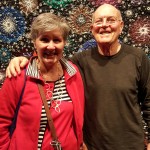Biennale of Australian Art, BOAA review
11/12/2018Biennale of Australian Art, BOAA 21 September to 6 November 2018
Ballarat, Victoria
The Biennale of Australian Art (BOAA) began its inaugural festival in Ballarat, just 1.5 hours on the train north of Melbourne. Ballarat originally was a gold mining town with many stunning heritage buildings built during the gold rush of the 1850’s. It was also famous for the Eureka Rebellion among many other things.
BOAA is an arts festival to showcase Australian artists and to create innovative contemporary art.
It had more than 150 artists, 65 solo exhibitions held around 14 locations across Ballarat. There was a variety of sculpture, installation, drawing, painting, photography, performance, music, huge painted landscapes. There was a free bus (to ticket holders), every so often taking viewers to each venue and there was no shortage of people and plenty of places for coffee.
Many of the heritage buildings are now empty and have been unused for many years, but were utilised for BOAA, which provided fascinating venues for art, music and performance. I attended BOAA on the second last two days and unfortunately did not have enough time to get to all the venues and artworks, so I will only mention those which stood out.
I began at the Ballarat Regional Art Gallery where I was greeted with Asher Bilu’s installations in several rooms; his work plays with light and shadow and celebrates the beauty of nature by reminding us of its fragility. I was very fortunate to meet Asher Bilu (Melbourne) who was very generous with his time and detailed explanations of his work. Further on were David Jenz (ACT) extraordinary sculptures, which transform our iconic corrugated iron. A local artist of Ballarat, Kim Anderson produced very large and emotional charcoal drawings of folds and external landscapes and in a light filled room was Pip & Pop’s neon saturated and hyper installation of sugar, glitter, crystals and artificial flora. Upstairs was work by Louiseann King (Vic). Her laces like bronzes were in response to the Ballarat Art Gallery’s collection of historical paintings, where King provided a colonial woman’s voice to historical paintings. Marlene Gilson (Ballarat) naive landscapes retold history’s that includes indigenous Australians of Ballarat and their treatment and injustices.
St Andrew’s Church housed very large (4-6m or more) landscapes paintings on easels. Andrew McIlroy (NSW) very long painting of an atmospheric landscape in St Andrews Church and Amy Joy Watson’s (SA) huge needlepoint landscape were the two stand-outs for me.
The George Farmer Building an abandoned small goods factory of 30 years prior, with peeling paint and dark, cold underground rooms, was very eerie, but a great venue for many of the artworks. Skunk Control’s (Vic) Fractured Alter was very popular. Created with alternative technologies, including a dichroic perspex spinning wheel in front of an alter of plastic and natural materials was transformative. Jill Orr photographed unreachable parts within the abandoned site and also did a performance within. The Tjanpi Desert Weavers woven creatures were very popular. The siblings Nawurapu and Djirrirra Wunungmurra (NT) room of black and white paintings and sculptures of organic spiralling forms and clouds were striking and finally Akiko Nagio (Vic) 2 metre long yet intricate paper cuts of hanging layers Peppercorn-like leaves stained with copper oxides were particularly fascinating and always an unexpected joy when you have the opportunity to met the artist as well, who happened to be on site.
Ballarat Welcome Centre in a previous life was an old girls boarding school. We were greeted by a volunteer who told us the brief history of the building. Jenny Crompton’s very delicate sculptures of wire and beaded organisms filled the centre of the hall with wonder and Louise Paramor’s (Vic) big and bold playful sculptures were placed throughout the chapel.
Lake Wendouree 6km Sculpture Walk and Eureka House were among other venues which unfortunately, we didn’t get to.
It was wonderful to see such an exhibition could be accomplished outside of a capitol city and within the regions. The idea to host a biennale in regional Victoria was contentious as Julie Collins the Artistic Director of BOAA explains in her message within the extensive catalogue how the idea ‘met with resistance from the beginning as it isn’t in Melbourne…’
Unfortunately there was some press about the artists at BOAA not receiving their full payment as promised. I do not know if this has been resolved as yet and hope the artists get their payment in full, ensuring BOAA’s continuation in 2020 and onwards.
More information can be found at https://www.boaa.net.au/ I will also leave a copy of the catalogue at Umbrella Studio, which will be available upon request for those who would like to see more.
Alison McDonald



















